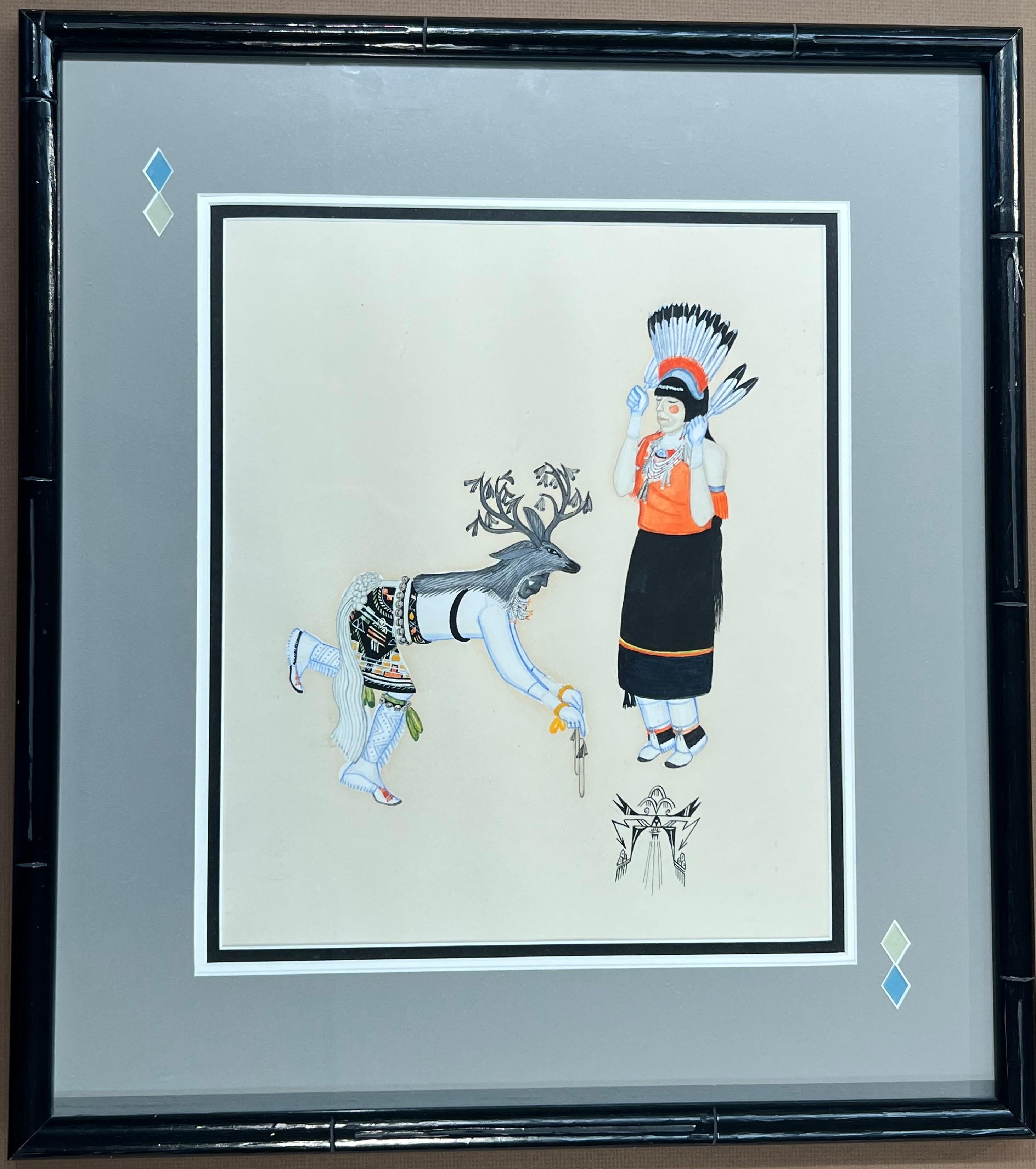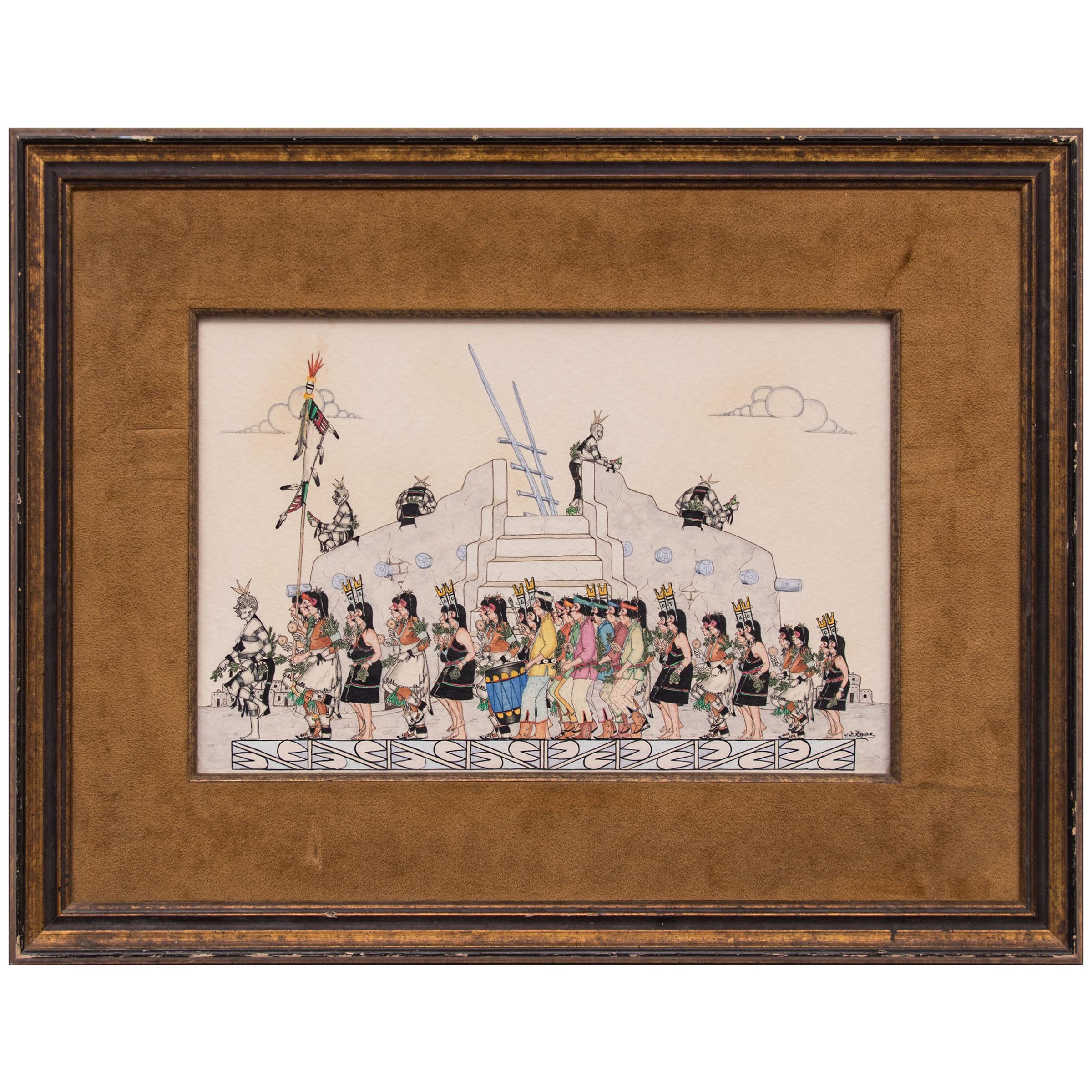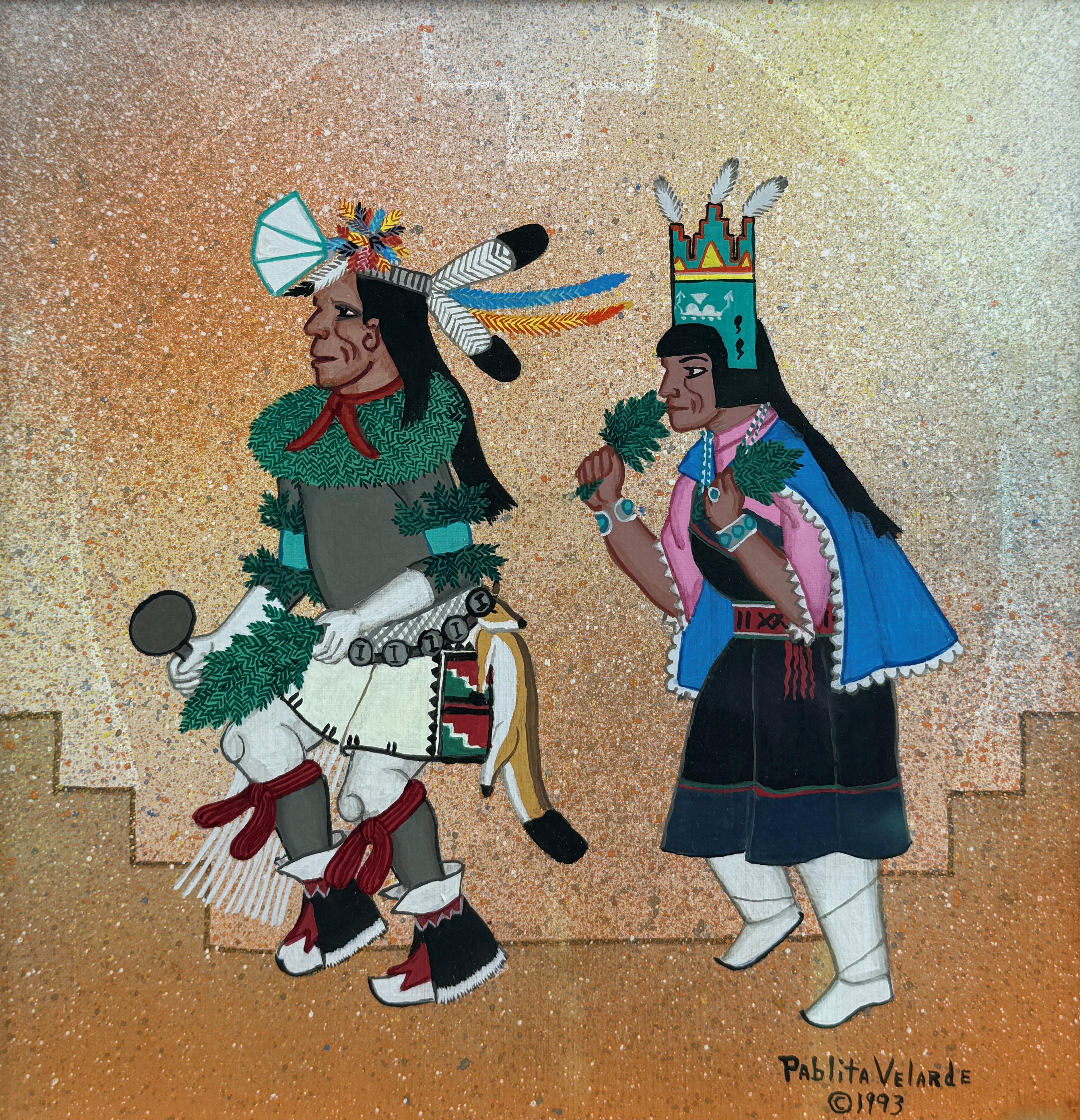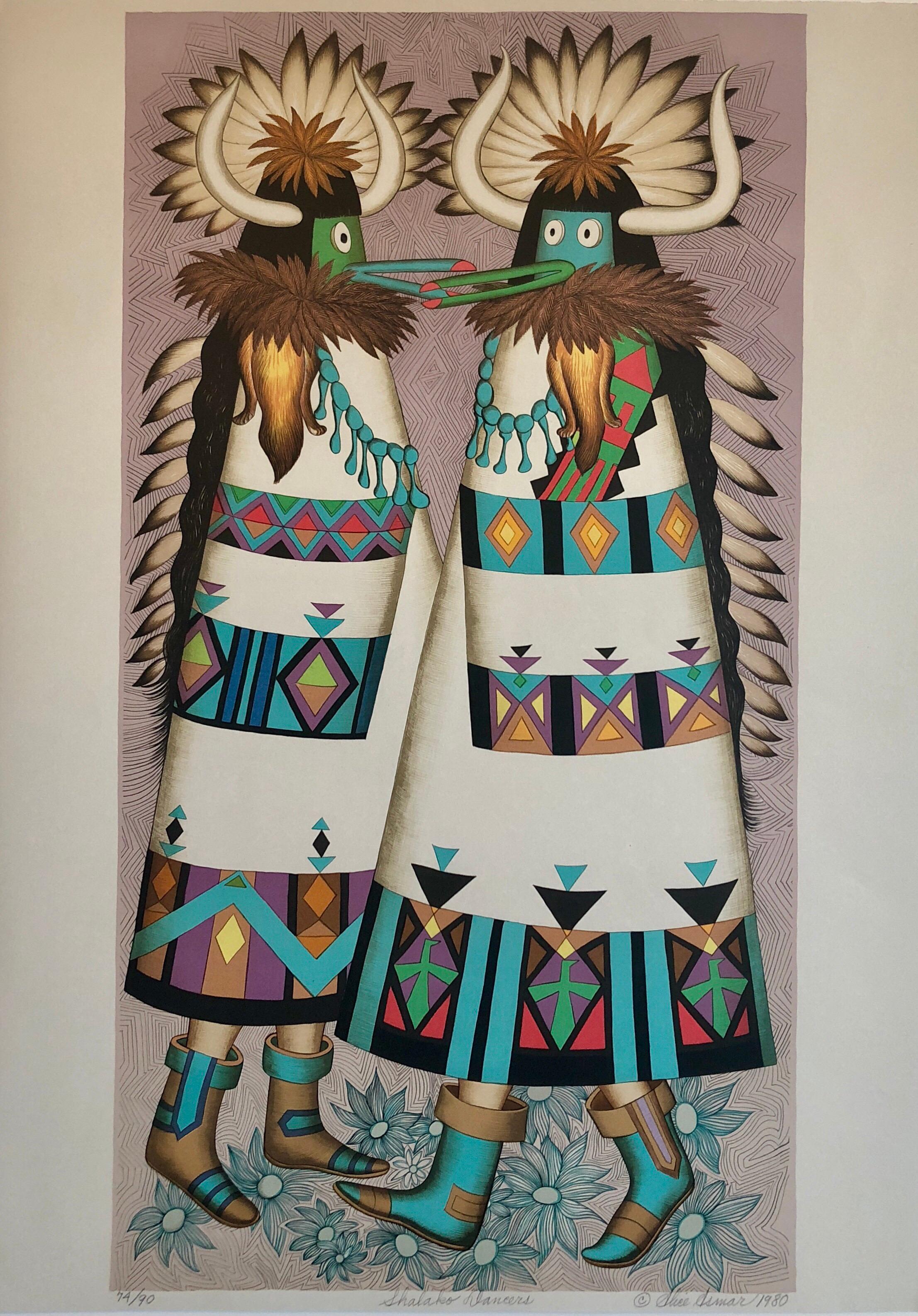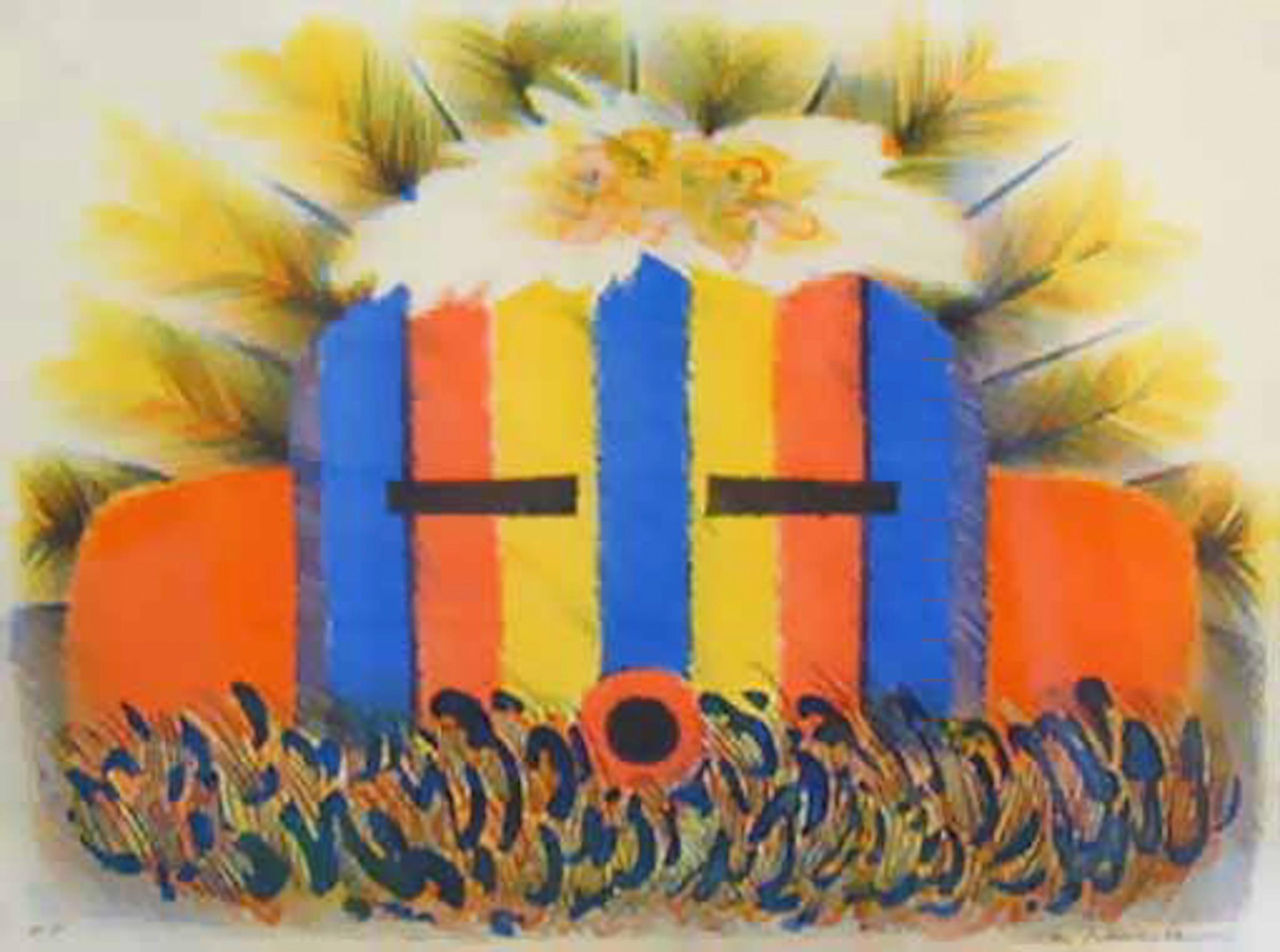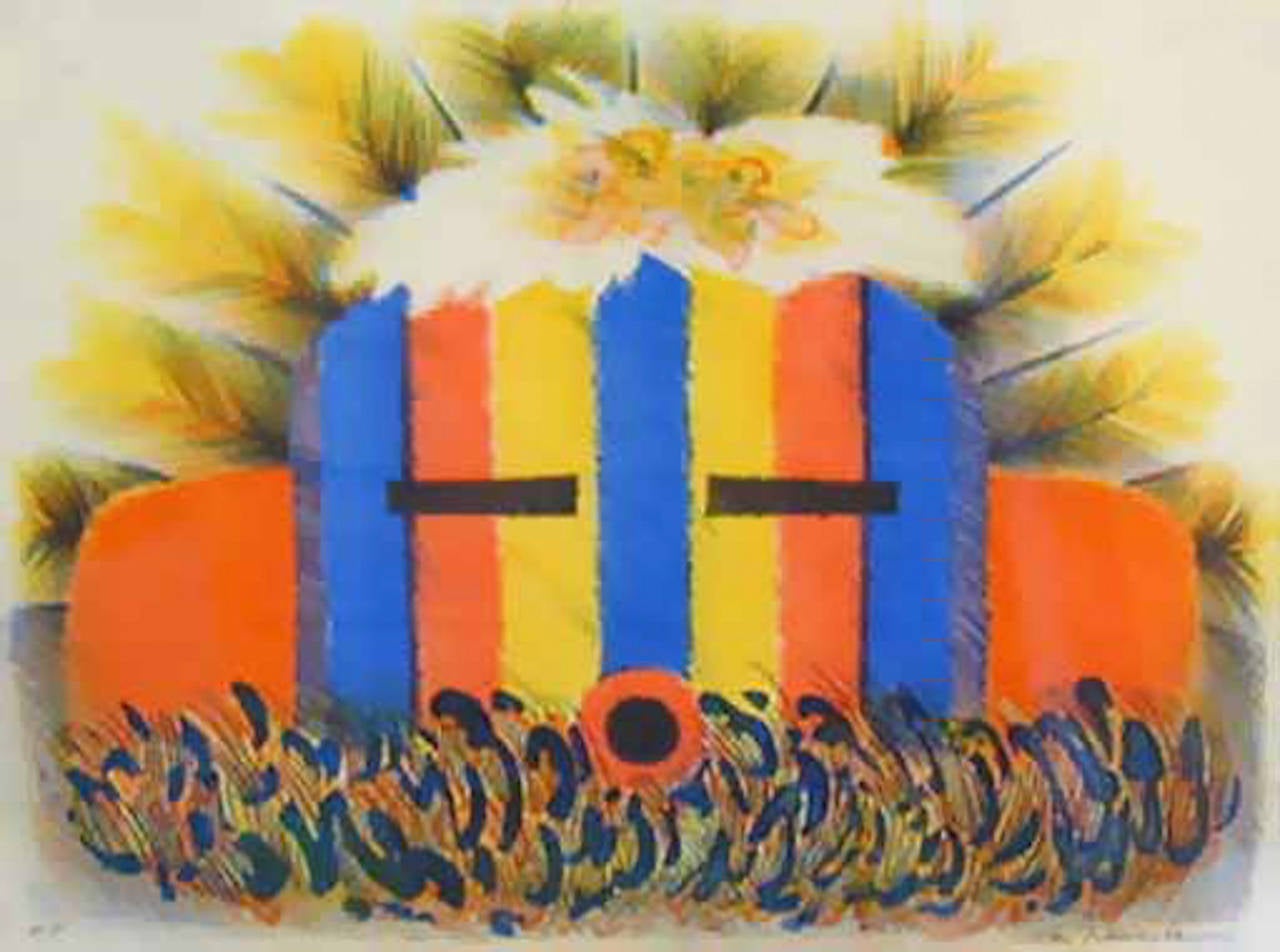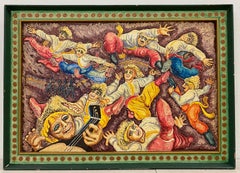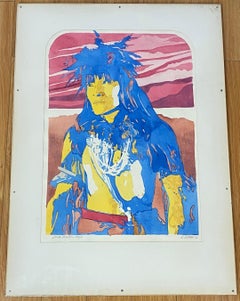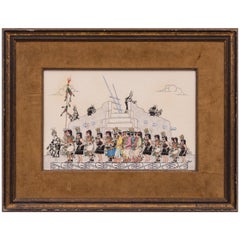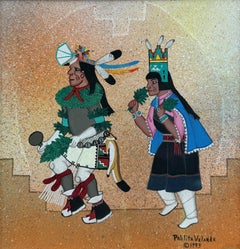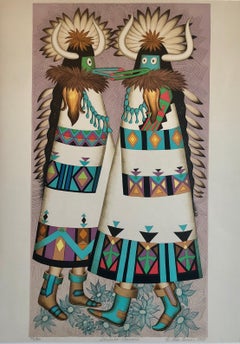Items Similar to Virgil Vigil "Pueblo Dancers" C.2007
Want more images or videos?
Request additional images or videos from the seller
1 of 13
Virgil VigilVirgil Vigil "Pueblo Dancers" C.20072007
2007
$550
£417.26
€478.42
CA$783.51
A$850.30
CHF 447.39
MX$10,331.15
NOK 5,601.25
SEK 5,274.08
DKK 3,572.12
About the Item
Virgil Vigil "Pueblo Dancers" C.2007
Dimensions 10" wide x 3.5" high
The frame measures 19.5" wide x 13" high
Signed and dated
Good vintage condition. Lightly distressed frame
- Creator:Virgil Vigil
- Creation Year:2007
- Dimensions:Height: 13 in (33.02 cm)Width: 19.5 in (49.53 cm)Depth: 1 in (2.54 cm)
- Medium:
- Period:
- Condition:
- Gallery Location:San Francisco, CA
- Reference Number:1stDibs: LU137827300932
About the Seller
4.9
Gold Seller
Premium sellers maintaining a 4.3+ rating and 24-hour response times
1stDibs seller since 2020
555 sales on 1stDibs
Typical response time: 4 hours
- ShippingRetrieving quote...Shipping from: San Francisco, CA
- Return Policy
Authenticity Guarantee
In the unlikely event there’s an issue with an item’s authenticity, contact us within 1 year for a full refund. DetailsMoney-Back Guarantee
If your item is not as described, is damaged in transit, or does not arrive, contact us within 7 days for a full refund. Details24-Hour Cancellation
You have a 24-hour grace period in which to reconsider your purchase, with no questions asked.Vetted Professional Sellers
Our world-class sellers must adhere to strict standards for service and quality, maintaining the integrity of our listings.Price-Match Guarantee
If you find that a seller listed the same item for a lower price elsewhere, we’ll match it.Trusted Global Delivery
Our best-in-class carrier network provides specialized shipping options worldwide, including custom delivery.More From This Seller
View AllRichard Whalen "Ukrainian Dancers" Original Oil Painting c.1990
By Richard Whalen
Located in San Francisco, CA
Richard Whalen (American, 1926-2009)
"Ukrainian Dancers" Original Oil Painting c.1990
Created on a wooden panel and housed in a handmade custom frame...
Category
Late 20th Century Figurative Paintings
Materials
Plywood, Oil
Vladan Stiha Native Americans in New Mexico
Located in San Francisco, CA
Vladan Stiha: 1908-1992. Well listed New Mexico artist with auction records over $12,000. He was born in Yugoslavia and tried to emigrate to the U.S. duri...
Category
1980s American Impressionist Figurative Paintings
Materials
Oil
Native American Pop Art "Snake Priest - Hopi" Original Watercolor by D. Collins
Located in San Francisco, CA
Native American Pop Art "Snake Priest - Hopi" Original Watercolor by D. Collins C.1971
Outstanding original Pop Art style watercolor by D. Collins...
Category
Mid-20th Century Pop Art Portrait Drawings and Watercolors
Materials
Watercolor
Amado Maurillo Pena Jr. " 5 Wise Men "
Located in San Francisco, CA
C. 20th Century - Beautiful " 5 Wise Men " Done by Amado Maurillo Pena Jr. ( Native American Serigraph )
Category
20th Century Figurative Paintings
Materials
Glass
“Adobe Wall Taos Pueblo”
Located in San Francisco, CA
In perfect simplicity, the essence of timeless Taos comes together in this picture. Start with the cerulean sky and particularly notice the light on the structure, a magnet to painte...
Category
1980s American Modern Landscape Paintings
Materials
Canvas, Oil
Melanie Lundquist "Kimono" Original Framed Serigraph C.1990
Located in San Francisco, CA
Melanie Lundquist "Kimono" Original Framed Serigraph C.1990
Fine vintage serigraph with gold tones and beautiful blues on a cream background
Housed...
Category
Late 20th Century Abstract Prints
Materials
Screen
You May Also Like
Deer Dance, painting by Tonita Pena, Santa Fe, Cochiti, Pueblo, male, female
Located in Santa Fe, NM
Deer Dance, painting by Tonita Pena, Santa Fe, Cochiti, Pueblo, male, female
Tonita Peña (born 1893 in San Ildefonso, died 1949 in Kewa Pueblo, New Mexico) was born as Quah Ah (meaning white coral beads) but also used the name Tonita Vigil Peña and María Antonia Tonita Peña. Peña was a renowned Pueblo artist, specializing in pen and ink on paper embellished with watercolor. She was a well-known and influential Native American artist and art teacher of the early 1920s and 1930s.
Tonita Peña was born on May 10, 1893, at San Ildefonso Pueblo, to Ascensión Vigil Peña and Natividad Peña of San Ildefonso Pueblo, New Mexico. When she was 12, her mother and younger sister died, as a result of complications due to the flu. Her father was unable to care for her and she was taken to Cochití Pueblo and was brought up by her aunt Martina Vigil Montoya, a prominent Cochití Pueblo potter. Peña attended St. Catherine Indian School in Santa Fe.
Edgar Lee Hewett, an anthropologist involved in supervising the nearby Frijoles Canyon excavations (now Bandelier National Monument) was instrumental in developing the careers of several San Ildefonso “self-taught” artists including Tonita Peña. Hewett purchased Peña's paintings for the Museum of New Mexico and supplied her with quality paint and paper. Peña began gaining more notoriety by the end of the 1910s selling an increasing amount of her work to collectors and the La Fonda Hotel. Much of this early work was done of Pueblo cultural subject matter, in a style inspired by historic Native American works, however, her use of an artist's easel and Western painting mediums gained her acceptance among her European-American contemporaries in the art world. At the age of 25, she exhibited her work at museums and galleries in the Santa Fe and Albuquerque area.
In the early 1920s, Tonita did not know how much her painting sold for at the Museum of New Mexico, so she wrote letters to the administrators because a local farmer was worried that she got paid too little.
In the 1930s Peña was an instructor at the Santa Fe Indian School and at the Albuquerque Indian School and the only woman painter of the San Ildefonso Self-Taught Group, which included such noted artists as Alfonso Roybal, Julian Martinez, Abel Sánchez (Oqwa Pi), Crecencio Martinez, and Encarnación Peña. As children, these artists attended San Ildefonso day school which was part of the institution of the Dawes Act of 1887, designed to indoctrinate and assimilate Native American children into mainstream American society.
In 1931, Tonita Peña exhibited at the Exposition of Indian Tribal Arts which was presented at the Grand Central Art Galleries in New York City. Works from this exhibition were shown at the 1932 Venice Biennial. That year is the only time Native American artists have shown in the official United States pavilion at that biennial, and Tonita Peña's paintings were part of that exhibition.[1 Her painting Basket Dance, that had shown in the Venice Biennial was acquired by the Whitney Museum of American Art in New York for $225. This was the highest price paid up to this time for a Pueblo painting...
Category
1940s Tribal Figurative Drawings and Watercolors
Materials
Paint, Paper
Jose Roybal San Ildefonso Pueblo Watercolor Painting, Pueblo Harvest Dance
By Jose Roybal
Located in Denver, CO
This original watercolor painting by San Ildefonso Pueblo artist Jose Roybal (1922–1978) beautifully captures the ceremonial Pueblo Harvest Dance, a celebr...
Category
Vintage 1970s American Native American Paintings
Materials
Paper
$2,600 Sale Price
60% Off
"Two Pueblo Dancers, Santa Clara" Pablita Velarde, New Mexico Native American
Located in New York, NY
Pablita Velarde
Two Pueblo Dancers, Santa Clara, 1993
Signed and dated lower right
Casein on paper
7 1/2 x 7 1/4 inches
Provenance
Adobe Gallery, New Mexico
Private Collection, Texa...
Category
1990s American Modern Figurative Paintings
Materials
Paper, Casein
Shalako Dancer, Native American Indian Lithograph California Woman Artist
By Alice Asmar
Located in Surfside, FL
American contemporary artist of Lebanese and Greek descent, Alice Asmar's art is often inspired by her love of nature, combined with a deep respect for native American culture, her work evolved into Southwestern themes of Indian Ceremonial Dance-Dramas, Indian portraits and landscapes.In 1991, Alice Asmar was chosen for prestigious Honorary Membership in the
National League of American Pen Women. Only three such honors are given each year. This recognition reaches back to her childhood, Alice Asmar was considered a child prodigy, winning awards and recognition for her artwork before the age of 10.
Her education from 1946 through 1959 included a BA magna cum laude, from Lewis and Clark College, Portland; an MFA from the University of Washington, Seattle; and a one-year fellowship to study at L'Ecole Nationale Superieure des Beaux-Arts, Paris, France. Born in Flint, Michigan of Lebanese and Greek descent. Her parents moved to Portland, Oregon when she was just a baby. The artwork of her early years was inspired by the splendors of nature, from the inscrutable pines and ancient sculptured rocks along the Oregon Coast to the mysterious ocean mists.
She Graduated magna cum laude from Lewis and Clark College in Portland and Obtained her Master's of Fine Arts Degree at The University of Washington in Seattle. Soon after graduating she accepted a job as an engineering drafter at Boeing Aircraft in Seattle. Her Assignment was clearing top secret drawing for air-to-ground missile. Alice worked for Boeing for less than a year. They offered her an engineering scholarship but she decided to go back to the art she loved doing from she was a child. After studying and traveling throughout the Near East, France, Switzerland, Italy, Yugoslavia, Turkey, The Greek Islands, Greece and Lebanon, Asmar set up studios in California, New Mexico and Oregon. A master of many media, Asmar is distinguished for her many techniques which include paintings in Oil, casein and Acrylic, drawing in ink, pencil and pastel, collage, tapestry, books,American contemporary artist of Lebanese and Greek descent, Alice Asmar's art is often inspired by her love of nature, combined with a deep respect for native American culture, her work evolved into Southwestern themes of Indian Ceremonial Dance-Dramas, Indian portraits and landscapes. Prints including lithography, etching, Engraving on metal on plexiglas, portraits, murals and banners. Her hand engraving of innovative designs for dinner and household wares for Nambe Mills in Santa Fe is recognized internationally.
Alice Asmar's works are in several hundred public and private collections in the United States and Europe, including the Smithsonian Institution, Franklin Mint, Portland Art Museum, Gene Autry Hotel in Palm Springs, Security Pacific International Bank of New York, The Public Art Museum of Gabrova, Bulgaria, kaiser-Permanente, and the Dr. Nicholas Townell collection in Angus, Scotland.
Studied with Edward Melcarth & Archipenko, University of Washington, MFA.
Work: National Museum of American History Smithsonian Institute, Washington. Los Angeles City-Scape at sunset (Mural), Commissioned by Dr. Walter jayasinghe, 66; Painting of doves, Bangs Manufacturing Co, Burbank
Exhibitions: Seattle Art Museum. Museum of Science & Industry, Los Angeles.
Circle Gallery Ltd, Houston, Abbot Hall Gallery, William Temple House, Portland Oregon. Nambe Mills, Santa Fe, New Mexico. Sr Eye Art Gallery, Long Beach. Descanso Gardens, La Canada Flintridge, California.Sun Cities Art Museum, Arizona. Audubon Art Exhibit, Portland Oregon.Walt Disney Art...
Category
1980s Contemporary Figurative Prints
Materials
Lithograph
Uncle of the Corn Dancers, Dan Namingha, Hopi, kachina, lithography edition
By Dan Namingha
Located in Santa Fe, NM
Uncle of the Corn Dancers, Hopi, kachina, lithography Dan Namingha
hand pulled limited edition lithograph
signed and numbered by the artists
Category
1970s Contemporary Figurative Prints
Materials
Lithograph
Uncle of the Corn Dancers, by Dan Namingha, limited, lithograph, Hopi, kachina
By Dan Namingha
Located in Santa Fe, NM
Uncle of the Corn Dancers,by Dan Namingha, limited, lithograph, Hopi, kachina
Uncle of the Corn Dancers, limited ed lithograph Hopi kachina Dan Namingha
unframed edition 125
Glenn...
Category
1980s Contemporary Figurative Prints
Materials
Lithograph
More Ways To Browse
Dali Hippocrates
Dali Horseman
Dali Illustrates Casanova
Dali Man Of La Mancha
Dali Othello
Dali Pig And Pepper
Dali Purgatory Signed
Dali Saba
Dali Signed Ecstatic
Dali Skeleton
Dali Spinning Man
Dali The Annunciation
Dali Thus Was Earth Created
Dame Laura Knight On Sale
Danos Flower Shop
Daumier Actualites
David Ham
David Schluss Serigraph
